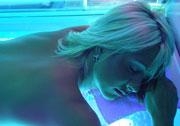Something new under the sun
Generation Y is becoming more complacent about the risk of melanoma and other types of skin cancer, according to a UNSW researcher.
Generation Y is becoming more complacent about the risk of melanoma and other types of skin cancer, according to a UNSW researcher.

Generation Y is becoming more complacent about the risk of melanoma and other types of skin cancer, according to a University of New South Wales (UNSW) researcher.
"The 'Slip, slop, slap' campaign in the 1980s and 1990s was very successful for Generation X - but despite increased awareness of the risks of unprotected sun exposure, many younger people still consider the "bronzed tan" to be an attractive ideal," said UNSW lecturer Dr Nadine Kasparian.
"It is vital that we continue to improve the ways in which we communicate with younger generations about melanoma risk," she said.
Dr Kasparian, who is based at the Department of Medical Oncology at the Prince of Wales Hospital, is part of an international project that is the most comprehensive study ever conducted into people's risk perception and reported behaviour in the sun.
The project is part of the GenoMEL research program into all aspects of melanoma risk, which involves geneticists, epidemiologists and psychologists at 22 centres including Australia, the US and in west and eastern Europe.
Participants from Australia are being sought to take part in the study, which will lead to the first personalized online assessment of the risk of developing a potentially deadly skin melanoma.
"The melanoma risk calculator will look at the combined impact of genetics, skin type, moles, hair, eye colour, sun exposure patterns, history of sunburn, people's sun protection behaviours and risk perceptions," she said.
The melanoma risk calculator will be available for free within five years.
"This information will allow people to better understand their melanoma risk - which is especially relevant in Australia, which has the highest incidence of the disease in the world," said Dr Kasparian. "We hope that ultimately it will also change people's behaviour."
The NSW Government's Cancer Institute figures show that melanoma rates in the ten years to 2005 have risen by 24 percent in women and 16 percent in men.
"There still seems to be a perception that to have a tan is healthy, but any change in skin colour is skin damage," Dr Kasparian said. "People need to be comfortable in their own skin - no matter what colour it is naturally."
For more information, or to take part in the study, go to the GenoMEL website
Media contacts: Dr Nadine Kasparian, 0414 251 204; or Susi Hamilton, UNSW media unit, 9385 1583 or 0422 934 024.